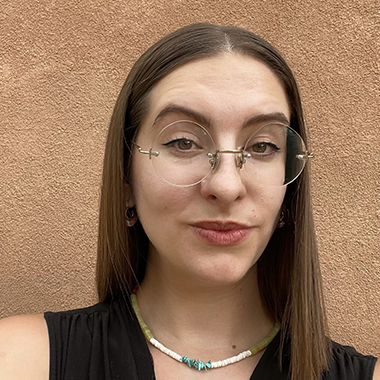
Assistant Professor of Anthropology, Department of Sociology and Anthropology
Course(s):
• Introduction to Archaeology (ANTH 2339)
|
“I am also dedicated to providing students with practical skills and culturally informed frameworks to prepare them to be leaders in diverse careers."
Tell us a little about your story, what brought you to UTA?
I am an anthropological archaeologist specializing in archaeological histories of the U.S. Southwest. I received my Ph.D. from the University of Arizona this summer with a dissertation in which I find evidence for significant innovations in blue-green paint technology in the Chaco Canyon of northern New Mexico (A.D. 850–1150). With important ties to water and healthy vegetation, blue-green is one of the most significant colors among communities in the Desert Southwest. My analysis of archaeological blue-green paint demonstrates that it was produced by synthesizing a previously unidentified mineral copper sulfate pigment. I argue that the development and display of new ways of creating blue-green was a significant catalyst for the emergence of plaza-based performances and systems of sodality-based governance, which are hallmarks of Pueblo communities today. Moving forward, I am working with Indigenous descendant communities to operationalize these results to better understand and reconcile the impacts of industrial copper mining in the U.S. Southwest.
I am excited to join the faculty at UTA because of the university-wide emphasis in community-based research, and the wealth of analytical resources available throughout campus. I have also been delighted to begin working with our students, who bring a wealth of experiences and such enthusiasm to the classroom.
What are your academic and research interests?
As an archaeologist, I am broadly interested in understanding people—their histories, struggles, and innovations—by studying their material culture. While I have worked throughout North and South America, I primarily work in the Four Corners region, where I work closely with Indigenous descendant communities to reconstruct community and land use histories using a combination of archaeometry, conservation science, and oral histories.
I am especially interested in histories of migration, community formation, collective action and cooperation among Indigenous communities through time. I treat museum collections as material archives and use archaeometry and conservation science to reconstruct histories of technological innovation and tradition, especially through archaeological paint. Paint is one of the oldest synthetic materials made by humans and is made following recipes requiring intimate knowledge of the environment. By reconstructing these recipes, I work to establish relationships to people, places, and traditions through time. Moving forward, I am working to further develop collaborative relationships with Indigenous descendant communities to use archaeological data to advocate for contemporary community needs related to industrial mining.
In addition, I am working to reconstruct geologic knowledge among contemporary communities of potters from Mata Ortiz in Chihuahua, Mexico. I am also a collaborator on the Pañamarca Field Project, studying painted mural traditions at the late Moche site of Pañamarca on the north coast of Peru, alongside representatives from the Peru Ministry of Culture, with Columbia University and the Denver Museum of Nature and Science.
I am also dedicated to providing students with practical skills and culturally informed frameworks to prepare them to be leaders in diverse careers. I am the co-director of an archaeological field school dedicated to providing students with practical skills for careers in cultural resource management, a billion-dollar industry that has been experiencing historic shortages of trained archaeologists. In its inaugural year, we successfully placed three graduates of our program in entry level archaeology careers. I am excited to offer similar opportunities for UTA students.
Any desired interdisciplinary collaborations?
I would love to build more connections with those in earth sciences and geosciences, especially those working with the effects of climate change. I would also love to work with anyone interested in workforce development for CoLA students, especially by developing community-based research and outreach work. To that end, I would be eager to work with anyone interested in developing local, place-based history or archaeology projects that prepare students for careers in cultural resource management, development, and city planning, while creating more nuanced local histories of the Dallas-Fort Worth area.
Any news releases or publications that you are featured in that you’d like to share?
Hanson, Kelsey E., Samantha G. Fladd, Sarah E. Oas, and Katelyn J. Bishop
2024 The Social Construction of Backdirt in Chaco Archaeology. Journal of Field Archaeology
49(2):129–139. https://doi.org/10.1080/00934690.2024.2307122
Anything else you’d like to share?
I am new to Texas and am always looking for recommendations for things to do (food, drinks, music, museums). I would also like to get more into cycling in the area. Any and all tips are welcome! 😊
|
